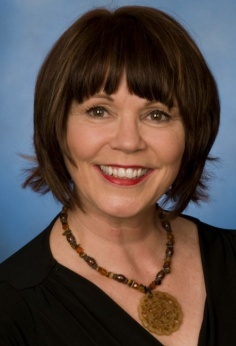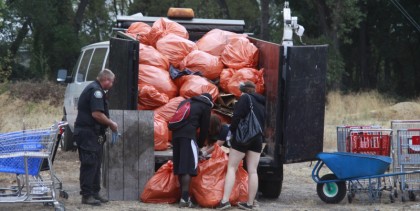Editor’s note: This is the second in a month-long-series of stories, slide shows and Q&As about Redding’s unsheltered homeless. These pieces will rotate throughout February, between our regular features and stories.
We start with descriptions of some of Redding’s most renowned encampments, and talk with people who’ve taken responsibility for cleaning them.
Our next conversations are with people who’ve worked – either personally or professionally – to help the unsheltered homeless in some capacity. We will also seek comment from the area’s leaders.
Finally, the homeless will get the last word.
As always, we welcome your civilized and respectful comments. We thank you for your willingness to hear and consider a variety of viewpoints on this sensitive, important issue that impacts our entire community.
Today we talk with Randy Smith, whose career as an anesthesiologist spanned 34 years. Since his retirement 13 years ago, he’s worked as a community volunteer, renowned for his dedication to developing and cleaning public recreational trails and open spaces, as well as his mission to eradicate arundo, an invasive, non-native plant. Regarding why he volunteers, Smith says, “There has been no higher calling, no work more worthwhile, than giving something back for everything received in this special place.”
Smith’s descriptions of discovered illegal encampments are what planted the seed of the idea for this series. Full disclosure: Smith is a long-time friend.
Q: Randy, thanks for taking time to talk with me today. Can you please start by sharing with readers a list of the various facets of volunteer work that have given you a front-line look at the issue of homeless encampments?
A: Caring for society’s problems in a volunteer (unpaid) setting began in medical school in Michigan during the 1960s. Further training at less- than-market rates occurred in San Francisco, then a few decades in Redding, then the seventh highest Medicaid-per-capita population county in the US.
Environment work with Rotary Club of Redding started for me in 1999. The first Rotary stream clean-up occurred on West Salt Creek in February of 2003. City of Redding once held Spring Clean-A-Thons (litter abatement) which were always attended after learning of them. Establishment of a willingness and ability to organize and mobilize community volunteers after this program was discontinued resulted in then-Mayor Ken Murray suggesting the bar be raised in early 2006 to include annual stream community wide efforts. This has been conducted each fall since. Additionally, work to eradicate non-native arundo, which began in the fall of 2004, has taken me to places rarely visited by the average hiker and casual walker in and near Redding.
Q: OK, so you’ve been outdoors a lot, often in areas that are away from the public eye. Can you tell us what you’ve seen in the way of evidence of homeless encampments?
A: Everything from a “two story apartment” made of wooden pallets over Calaboose Creek below California at Lincoln to visqueen tents strung on clothesline between two trees and, of course, brand new sleeping bags discarded on the ground when they became wet and all manner of variation in between what is listed.
Q; What was – and is – your reaction?
A: Disappointment slightly trumps anger that human beings can be so disrespectful, so reckless, so unconcerned as to so selfishly despoil our precious public places.
Q: Can you describe the range of kinds of homeless “campers” you’ve encountered during your work?
A: Illegal campers run the gamut of humankind from the affluent healthy drug using and generally toasted young adult to the mentally ill senior. Children are rarely seen and always reported.
Q: As a retired physician, what were your observations about some of their physical conditions – albeit from afar?
A: In another age and less favorable climate, many of these people would have perished from exposure, from infectious disease. Remember Shasta County once had malaria, and TB founded the former Shasta General Hospital. But generally, these folk exist above subsistance, certainly better nourished and clothed than the Northern Paiute who once lived a little east of Redding, though most commonly very dirty, usually in need of dental work and without exception save twice in my wanderings, peaceful and without malice.
Q: In October you were instrumental in helping organize hundreds of volunteers from your Rotary club, service groups and community members to clean up what’s known as the Henderson Open Space. What was the before-and-after situation like by the end of that work weekend?
A: Short answer is 10,256 pounds of human debris were removed from Henderson Open Space on Saturday morning, Oct0ber 1, 2011.
This followed a decade of work by now-retired CDFG (California Department of Fish and Game) Warden Dan Fehr and CSO (Community Service Officer) Robert Brannon in which they removed over 100,000 pounds of human debris from this same parcel.
The work of over 200 volunteers was wonderful. It was not a final statement, but a beginning of the community recognition that these special places are not surrendered, not abandoned. There was a Boston Commons before there was a government. Stewardship of the land is our collective responsibility.
Q: In your personal opinion, what is the greatest cause of people living in homeless encampments?
A: Except for the mentally ill, people I have interviewed say they are present in these circumstances because they are free people who do not like the rules which come from other choices of living arrangements.
Q: If you had the power and money to solve the homeless encampment problem, what would you suggest?
A: Just as I was powerless to stop teen pregnancy or driving drunk or shooting police officers or severe spousal abuse; so, too, am I powerless to stop illegal camping. But that powerlessness does not foster inactivity, nor is it an excuse to allow desecration to occur without challenge.
Q: Anything else you’d like us to know?
A: We live in one of the most beautiful places I have ever seen in all 50 states and more than that number of countries. The need to protect and preserve our natural surroundings has never been greater. Please copy and follow President Theodore Roosevelt’s 1908 quote which inspires and encourages me every day: “We must handle the water, the wood, the grasses so that we will hand them on to our children and our children’s children in better and not worse shape than we got them.”
Click here for Part 1 of this series: Homeless Encampments: RPD Deals with Another Part of the City
Click here for the story about the community development of the Henderson Open Space.
 Independent online journalist Doni Chamberlain founded what’s now known as anewscafe.com in 2007 with her son, Joe Domke of the Czech Republic. Prior to 2007 Chamberlain was an award-winning newspaper opinion columnist, feature and food writer recognized by the Associated Press, the California Newspaper Publishers Association and E.W. Scripps. She lives in Redding, CA.
Independent online journalist Doni Chamberlain founded what’s now known as anewscafe.com in 2007 with her son, Joe Domke of the Czech Republic. Prior to 2007 Chamberlain was an award-winning newspaper opinion columnist, feature and food writer recognized by the Associated Press, the California Newspaper Publishers Association and E.W. Scripps. She lives in Redding, CA.






